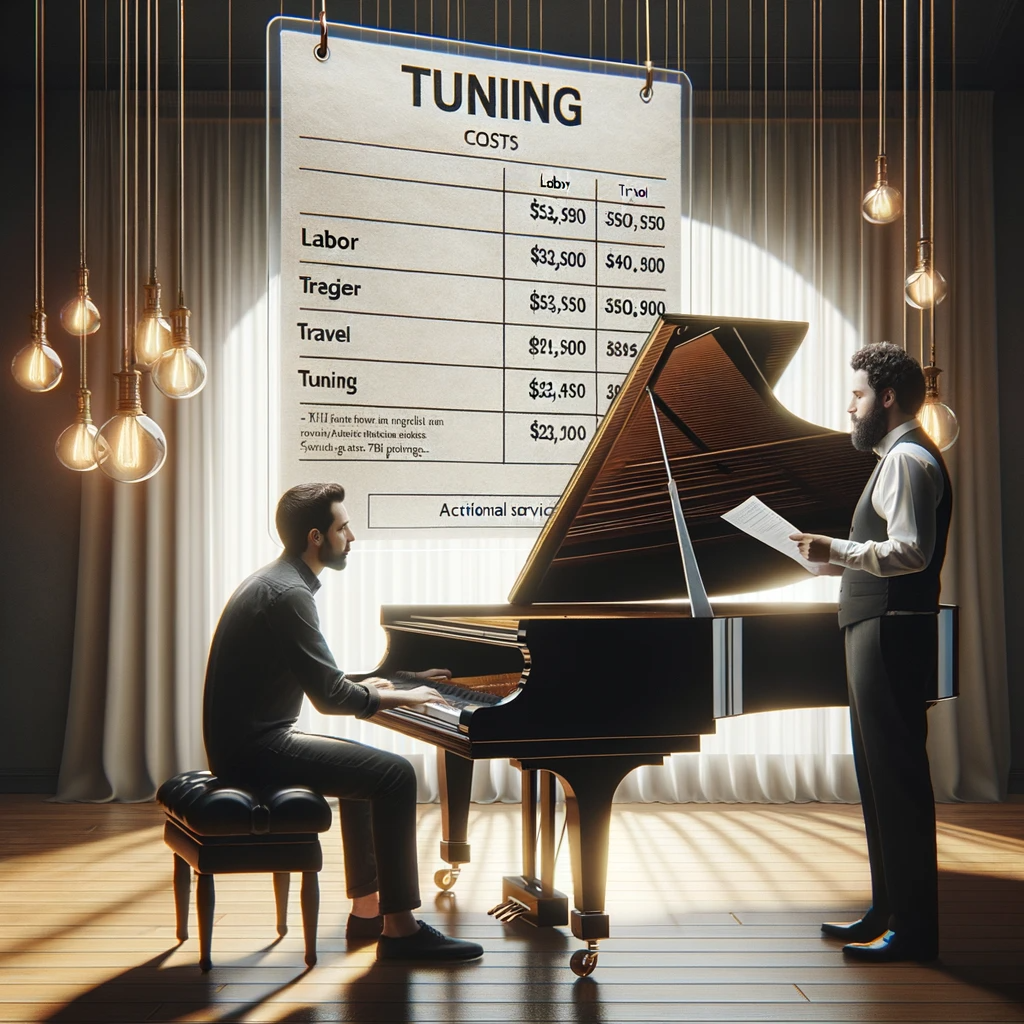Introduction

Piano tuning is the process of adjusting the tension of the piano strings to ensure that each note produces the correct pitch and harmonizes with other notes. It is a crucial maintenance activity for pianos as it helps maintain their overall sound quality, clarity, and musicality. Without regular tuning, a piano can gradually go out of tune due to factors like changes in temperature and humidity or consistent playing.
Brief Explanation of Piano Tuning and Its Importance
Piano tuning involves carefully adjusting the tension on each string by using a specialized wrench. The tuner listens to the sound produced by each note and makes precise adjustments until they achieve optimal tonal balance across the entire instrument.
This process helps ensure that when a key is struck, it produces the intended pitch accurately. The importance of piano tuning lies in its direct impact on the sound quality and playability of the instrument.
A well-tuned piano enables musicians to create beautiful music with accurate intonation, harmonies, and dynamics. It also enhances their ability to express emotions through variations in tone color and timbre.
Overview of Factors That Influence Piano Tuning Cost
Several factors influence the cost associated with piano tuning services:
1. Frequency of Tuning: The frequency at which a piano needs tuning can vary depending on usage and environmental conditions. Generally, professionals recommend having pianos tuned at least once or twice a year for optimal performance.
2. Piano Condition and Age: Older pianos or those that have not been regularly maintained may require additional work during tuning sessions. Issues such as loose pins or worn-out parts can affect stability and result in increased costs.
3. Geographical Location: The cost of piano tuning services can vary based on regional differences in living expenses, market demand for tuners, and competition among service providers.
4. Piano Type and Size: The complexity involved in tuning different types of pianos, such as uprights, grand pianos, or baby grands, can influence the cost.
Larger pianos may require more time and effort to achieve precise tuning. Considering these factors will help individuals understand the various aspects that contribute to the overall cost of piano tuning services.
Frequency of Tuning
Explanation: Regular tuning is necessary to maintain the optimal sound quality and performance of a piano. Recommendations: Tuning frequency varies based on usage and environment. For pianos used in professional performances or recording studios, tuning every 3-6 months is typically recommended.
In moderate home use, pianos should be tuned at least once a year. However, factors such as temperature and humidity fluctuations can affect the stability of a piano’s pitch, requiring more frequent tunings in certain environments.
Piano Condition and Age

Impact: Wear and tear on the piano can lead to instability in its overall sound and pitch. Older Pianos: As pianos age, they may require more extensive work during tuning due to mechanical issues or parts that have deteriorated over time. This can increase the cost of tuning as additional adjustments or repairs are needed to restore proper functionality.
Geographical Location
Comparison: Piano tuning costs can vary in different regions or countries due to differences in living expenses and market demand. In areas with higher living expenses, such as large cities, piano tuners may charge more for their services. Similarly, areas with a high demand for piano tuners may also result in higher prices due to limited availability.
Piano Type and Size
Differences: The complexity of tuning varies based on the type of piano. Upright pianos are generally less complex compared to grand pianos or baby grand pianos which have more strings and a larger soundboard.
Consequently, grand pianos tend to require more time and effort during the tuning process, leading to increased costs.
Professional Piano Tuners vs DIY Tuning Kits

Advantages of hiring a professional tuner
Professional tuners possess expertise in identifying underlying issues beyond basic tuning needs. They have the knowledge and experience to diagnose and address any potential problems with the piano’s mechanical components, such as strings, hammers, or dampers. By understanding the intricate workings of a piano, they can ensure that all elements function optimally, resulting in improved sound quality and performance.
Additionally, professional tuners have the ability to make adjustments that go beyond simple tuning. They can fine-tune the instrument based on individual preferences or specific musical requirements.
This includes modifying the touch response of keys, regulating action mechanisms, adjusting pedal sensitivity, or voicing the hammers to achieve desired tonal qualities. These nuanced adjustments can greatly enhance playing experience and overall enjoyment of the instrument.
Disadvantages of DIY piano tuning kits
DIY piano tuning kits come with some inherent disadvantages. One major drawback is the lack of experience that individuals attempting self-tuning may have.
Without proper knowledge and training, they may unknowingly cause damage to sensitive parts of the piano while trying to adjust its pitch. Mishandling delicate strings or other components could lead to costly repairs or even render the instrument unplayable.
Another difficulty associated with DIY tuning is achieving precise results without professional guidance. A trained tuner possesses not only an understanding of how each string should sound but also an ear trained to detect subtle differences in pitch that an untrained individual may not notice.
Achieving accurate and consistent results requires a level of expertise developed through years of practice and training. Without this expertise, DIY enthusiasts may struggle to achieve satisfactory results despite their best efforts.
Tuning Techniques & Methods
Aural Tuning: The Art of Precision
Professional piano tuners use aural tuning, a traditional method that relies solely on their trained ear. They skillfully listen to the pitch, harmony, and quality of each note to bring the piano into perfect tune.
Using specialized tuning forks as a reference point, they meticulously adjust the tension in each string to achieve the desired pitch. This technique requires deep knowledge and experience in discerning subtle variations in sound.
Electronic Tuning: Precision at Your Fingertips
Another method utilized by professional piano tuners is electronic tuning. By utilizing electronic devices with advanced algorithms and sensors, precise measurements of each note’s frequency can be obtained.
These devices analyze the deviations from the desired pitch and guide tuners to make accurate adjustments. Electronic tuning provides an objective assessment of the instrument’s overall pitch and ensures consistency across all notes.
In-depth Discussion on Aural Tuning
Aural tuning involves a meticulous process that requires concentration, skill, and sensitivity from professional piano tuners. They carefully listen for beats caused by slight frequency differences between two notes played simultaneously to identify any discrepancies in pitch.
By strategically adjusting the tension using specialized tools like tuning hammers or wrenches, these skilled artisans gradually bring every string into harmonious alignment. Throughout this process, tuners must consider factors such as temperature and humidity that can affect string tension over time.
They rely on their honed sense of hearing to detect even subtle changes during this precise adjustment process. Aural tuning not only ensures accurate pitches but also allows for artistic interpretation based on individual preferences or specific musical styles.
Conclusion
In the world of piano tuning techniques, both aural and electronic methods offer distinct advantages depending on various factors such as tuner expertise and personal preferences. Each method showcases the dedication and artistry of professional piano tuners who strive to bring out the best in every instrument.
By combining their acute hearing and technical knowledge, aural tuners achieve exquisite precision through their intimate connection with the instrument. On the other hand, electronic tuning provides an objective assessment that enhances efficiency and consistency.
Ultimately, both techniques contribute to the goal of creating a beautifully tuned piano that resonates harmoniously with its players and listeners. So whether you lean towards the timeless artistry of aural tuning or embrace the precision of electronic methods, rest assured that your piano’s soulful melodies will be brought to life by these skilled tuners who passionately dedicate themselves to their craft.